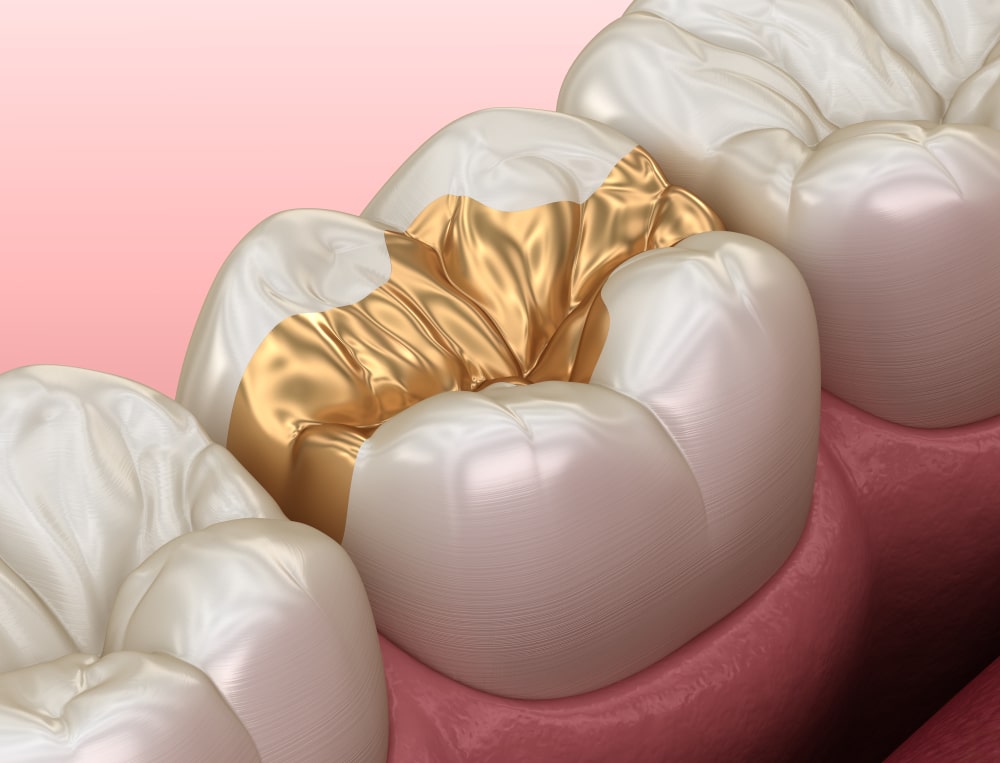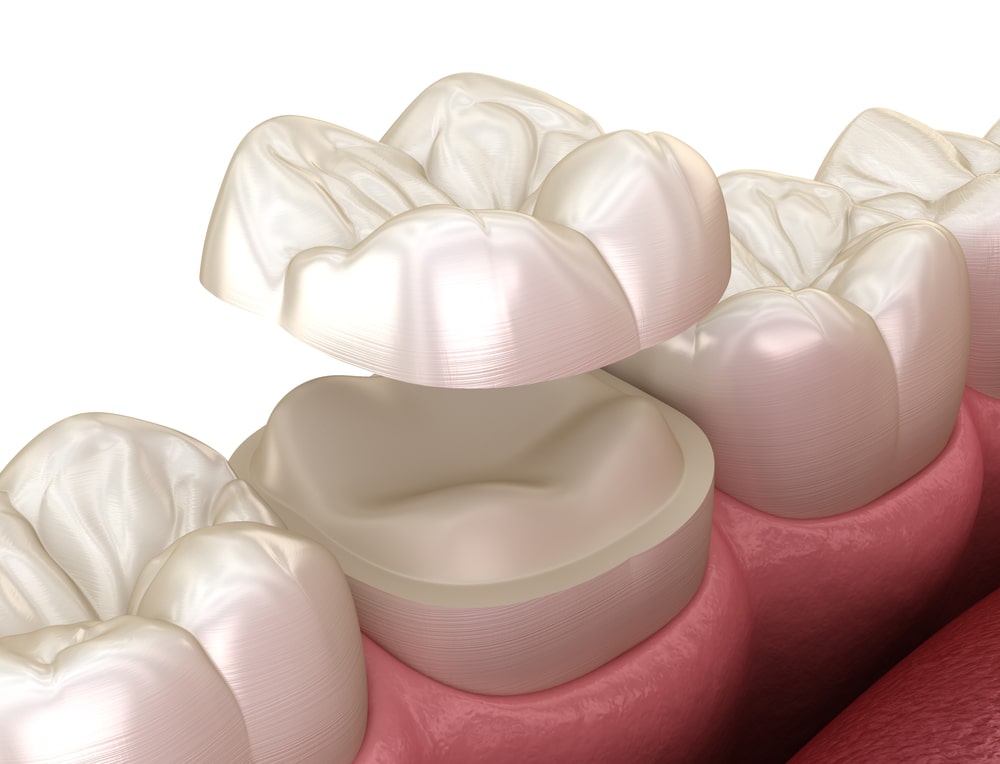Imagine investing in a beautiful, durable piece of furniture for your home. You wouldn’t just bring it home and forget about it, right? You’d clean it, protect it, and maintain it to ensure it lasts for years, preserving its beauty and function. The same principle applies to your dental health, especially when it comes to sophisticated restorations like inlays and onlays. Often hailed as the “middle ground” between traditional fillings and full dental crowns, inlays and onlays offer a durable, tooth-preserving solution for teeth with moderate decay or damage. But like any good investment, their longevity and effectiveness depend heavily on understanding what they are and, crucially, how to care for them properly.
At Bur Oak Dental, we believe that informed patients are empowered patients, and this guide is your first step to maximizing the life of your inlays and onlays.
What Are Inlays & Onlays, Anyway? Your Bridge Between Fillings and Crowns
When a tooth has more damage than a simple filling can repair, but not enough to warrant a full crown, that’s where inlays and onlays shine.

golden teeth inlay
They’re custom-made restorations, often crafted from porcelain, composite resin, or gold, designed to fit precisely into or onto your tooth.
The distinction between the two is all about coverage:
- Inlay: An inlay fits within the cusps (the raised points) of your tooth, similar to a traditional filling, but it’s typically used for larger cavities or damage confined to the chewing surface between the cusps.
- Onlay: An onlay is more extensive. It not only fills the area within the cusps but also covers one or more of the cusps themselves. Think of it as a partial crown, offering greater protection and strengthening to the tooth’s structure, particularly when a cusp is weakened or damaged.
Unlike fillings, which are molded directly into your tooth during a single visit, inlays and onlays are typically fabricated in a dental lab based on a precise impression of your tooth.

This process allows for superior fit, strength, and aesthetics.
Why choose an inlay or onlay?
They offer several compelling advantages over traditional fillings, especially for larger restorations:
- Superior Strength: Lab-fabricated restorations are often much stronger and more durable than direct fillings.
- Tooth Preservation: They allow for more of your natural tooth structure to be preserved compared to a full crown.
- Excellent Fit: Custom fabrication ensures a precise fit, reducing areas where bacteria can hide.
- Longevity: With proper care, they can last significantly longer than many traditional fillings.
- Aesthetics: Porcelain and composite options can be matched to your natural tooth color, making them virtually invisible.
The Lifespan: How Long Will Your Investment Last?
So, how long can you expect your inlay or onlay to last? The good news is, these restorations are built for durability.
On average, you can expect an inlay or onlay to last anywhere from 5 to 30 years, often surpassing the lifespan of traditional dental fillings which typically last 5-7 years.
However, this is a broad range, and several factors play a significant role in determining where your restoration falls on this spectrum.
Key Factors Influencing Longevity:
- Material Choice:
- Gold: Often considered the “gold standard” for durability, gold inlays/onlays can last 15-30 years, sometimes even longer, due to their strength and biocompatibility.
- Porcelain (Ceramic): Highly aesthetic and strong, porcelain can last 10-20 years. They are resistant to staining but can be more prone to chipping than gold if subjected to extreme forces.
- Composite Resin: A more affordable and tooth-colored option, composite inlays/onlays typically last 5-15 years. They are more susceptible to staining and wear over time compared to porcelain or gold.
- Oral Hygiene Habits: This is paramount. Consistent and thorough brushing and flossing prevent new decay around the margins of the restoration, which is a common cause of failure.
- Diet and Habits:
- Hard Foods: Chewing on ice, hard candies, or even habitually biting on pens can stress and chip any restoration, especially porcelain.
- Sticky Foods: Can potentially dislodge or damage the bond of your restoration over time.
- Bruxism (Teeth Grinding/Clenching): This involuntary habit puts immense pressure on your teeth and restorations, significantly shortening their lifespan. A custom nightguard is crucial if you grind your teeth.
- The Original Tooth Condition: A restoration on a tooth with extensive prior damage or existing cracks may not last as long as one placed on a relatively healthier tooth.
- Dentist’s Skill: The precision of the preparation and bonding process is vital for the long-term success of the inlay or onlay.
Myth vs. Fact: Many patients mistakenly believe that once a tooth is restored, it’s immune to further problems. This is a common misconception. While inlays and onlays are incredibly durable, they are not permanent in the sense that they’ll last forever without any care.
They still require diligent attention and can be susceptible to new decay or damage if neglected.
The Art of Care: Daily Habits for Lasting Inlays & Onlays
The secret to maximizing your investment isn’t complex; it’s consistent. Here’s your comprehensive guide to nurturing your inlays and onlays for decades of healthy smiles.
Immediately After Your Procedure
It’s normal to experience some temporary sensitivity to hot or cold temperatures, or some tenderness in the treated area for a few days after your inlay or onlay is placed. This typically subsides as your tooth settles.

If you received a temporary restoration while your permanent one was being fabricated, be extra gentle, avoid chewing directly on it, and be cautious with sticky foods to prevent dislodgement.
If sensitivity persists or worsens, don’t hesitate to contact our team.
Your Daily Care Routine
- Brushing Like a Pro:
- Soft-Bristle Brush: Always use a soft-bristle toothbrush to avoid abrasive wear on both your natural teeth and restorations.
- Fluoride Toothpaste: A non-abrasive fluoride toothpaste helps strengthen your enamel and protect against decay around the restoration margins.
- Gentle Technique: Brush for at least two minutes, twice a day, using gentle, circular motions. Pay extra attention to the gumline and the areas where your restoration meets your natural tooth structure.
- Flossing is Non-Negotiable:
- Daily Flossing: Flossing removes plaque and food particles that brushing can miss, especially between teeth and around the edges of your inlay or onlay. This is critical for preventing new decay.
- Proper Technique: Gently slide the floss between your teeth, curving it around the side of each tooth in a “C” shape and moving it up and down.
- Avoid “Snapping” Floss: Be gentle. Snapping floss down forcefully can potentially damage the delicate gum tissue or even the restoration’s margin over time.
- Water Flossers: These can be excellent adjuncts to traditional flossing, especially for cleaning around complex restorations or if you find traditional flossing challenging.
- Dietary Considerations: What to Steer Clear Of, What to Be Mindful Of:
- Steer Clear Of:
- Hard Candies, Ice, Popcorn Kernels: These can fracture or chip even the strongest restorations.
- Chewing on Non-Food Items: Pens, fingernails, etc., are culprits of dental damage.
- Extremely Sticky Foods: Caramel, taffy, or gummy candies can potentially pull at or dislodge restorations, especially if the bond is compromised.
- Be Mindful Of:
- Highly Acidic Foods/Drinks: Frequent consumption of sodas, citrus, or highly acidic foods can erode enamel and potentially compromise restoration margins over a very long time.
- Staining Foods/Drinks: Coffee, tea, red wine, and berries can stain composite resin inlays/onlays over time, though porcelain is highly resistant.
- Habit Protection:
- Nightguards for Bruxism: If you clench or grind your teeth (bruxism) – often unknowingly in your sleep – a custom-fitted nightguard is perhaps the single most important investment you can make to protect your teeth and restorations from excessive wear and fracture. This is a common habit that drastically reduces the lifespan of dental work.
- Sports Guards: If you play contact sports, a custom sports guard is essential to protect your teeth and dental work from impact.
Material Matters: Tailoring Your Care (Briefly)
While the core principles of care remain the same, here’s a quick note on specific materials:
- Porcelain: Very strong and aesthetic, but can be susceptible to chipping under extreme force. Be diligent about avoiding hard foods.
- Composite Resin: More prone to staining over time compared to porcelain. Regular professional cleanings and being mindful of staining foods/drinks will help maintain its appearance.
- Gold: Exceptionally durable and kind to opposing teeth. Care primarily involves routine hygiene.
Troubleshooting Common Concerns: When to Call Your Dental Friend
Even with the best care, sometimes issues arise. Knowing what signs to look for and when to contact your dentist can save your restoration (and your natural tooth) from further problems.
Common Problems to Watch For:
- Sensitivity (Prolonged or Worsening): Some initial sensitivity is normal. However, if sensitivity to hot or cold becomes sharp, prolonged, or increases over time, it could indicate an issue with the restoration’s bond, a new cavity, or even a deeper nerve irritation.
- Chipping or Cracking: Any visible damage to the inlay or onlay, no matter how small, warrants a check-up. Even a minor chip can compromise the integrity of the restoration and the underlying tooth.
- Food Trapping or Loose Feeling: If you suddenly notice food getting consistently trapped around the restoration, or if it feels loose when you chew, the bond may have failed, or the restoration might be coming off.
- Dullness or Staining (for composite): While not an emergency, if your composite inlay/onlay is losing its luster or picking up stains, it might be time for a professional polishing or assessment.
What NOT to Do: Never attempt to repair a chipped, loose, or damaged inlay/onlay yourself. Using household adhesives or trying to “pop” a loose restoration back into place can cause more harm than good, potentially leading to swallowing the restoration, further tooth damage, or infection. If you experience any of these symptoms, especially pain or looseness, it’s crucial to reach out to us right away. Ignoring a problem can lead to more extensive and costly dental work down the road, potentially even requiring Emergency Dental Care.
Your Partner in Longevity: Regular Dental Visits
Your home care routine is the daily defense, but regular dental check-ups are your long-term strategy for maximizing your inlay and onlay investment.

At Bur Oak Dental, we recommend professional check-ups and cleanings every six months (or as advised by your dentist).
During these visits, your dental hygienist will meticulously clean your teeth and around your restorations, removing plaque and tartar that even the most diligent brushing and flossing might miss.
Your dentist will also carefully examine your inlays and onlays for any signs of wear, chipping, marginal gaps, or new decay.
We’ll check your bite, assess for signs of grinding, and ensure your restorations are functioning perfectly. Early detection of any issues means simpler, less invasive, and more affordable solutions.
Think of your regular dental visits as essential maintenance checks for your valuable dental investments. Ready to ensure your smile stays in top condition? Contact us today.
Your Questions Answered: Inlays & Onlays FAQ
Here are some common questions we hear from patients about inlays and onlays:
What’s the main difference between an inlay and an onlay?
An inlay fits within the chewing surface of your tooth, between the cusps (the raised points). An onlay is more extensive, fitting within the cusps and covering one or more of the cusps to provide more structural support.
Are inlays and onlays painful to get?
The procedure for getting an inlay or onlay is similar to getting a filling, and your tooth will be numbed with local anesthetic, so you shouldn’t feel any pain during the treatment itself. Some temporary sensitivity or tenderness after the anesthetic wears off is normal, but it typically subsides within a few days.
Can I whiten my teeth with inlays/onlays?
Dental restorations like inlays and onlays, whether made of porcelain or composite, will not change color with professional teeth whitening treatments. If you plan to whiten your teeth, it’s generally recommended to do so before getting your inlay or onlay so that the restoration can be matched to your new, brighter tooth shade. Otherwise, your natural teeth might whiten, leaving your restoration looking darker. Learn more about teeth whitening services.
What are the benefits of choosing an inlay or onlay over a traditional filling?
For moderate decay, inlays and onlays offer superior strength, durability, and a more precise fit than traditional fillings. They also help preserve more of your natural tooth structure compared to a full crown, making them a more conservative yet highly effective choice.
How do I know if I need an inlay or onlay?
Only a thorough examination by your dentist can determine if an inlay or onlay is the right solution for you. They will assess the extent of the decay or damage to your tooth and recommend the most appropriate restorative option.
Can they be repaired if they chip?
Minor chips on an inlay or onlay can sometimes be repaired, depending on the material and the extent of the damage. However, more significant damage may require replacement of the entire restoration. It’s always best to have any damage assessed by your dentist promptly.
Investing in Your Smile’s Future
Choosing an inlay or onlay is a smart decision for strengthening a compromised tooth and protecting your long-term oral health.
By understanding these custom restorations and committing to a diligent care routine—from daily brushing and flossing to protecting against harmful habits and maintaining regular dental check-ups—you’re not just preserving a restoration; you’re preserving your natural tooth and ensuring your investment pays dividends in comfort, function, and a confident smile for years to come.
At Bur Oak Dental, we’re dedicated to providing comprehensive, patient-centered care and equipping you with the knowledge to maintain optimal oral health.
If you have any questions or are considering a restoration, don’t hesitate to book a consultation with our friendly team. We’re here to help you every step of the way!


